![]() F1415 Stratigraphic Project Aegina Kolonna
F1415 Stratigraphic Project Aegina Kolonna
Principal Investigator: Prof. Dr. Florens Felten1
Co-investigator: Dr. Walter Gauss
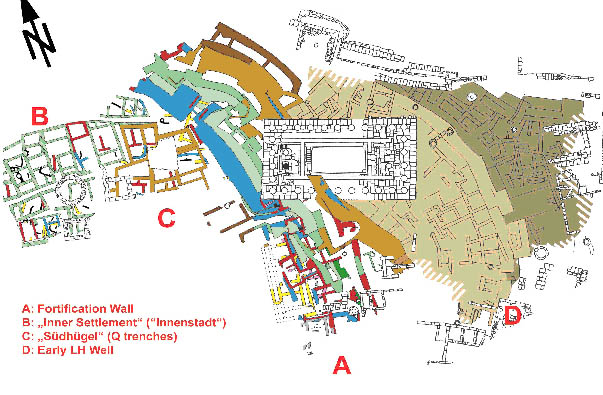
Fig. 1: Aegina Kolonna and the four areas of research within the SCIEM 2000 project
General:
Aegina was one of the major centres of the Aegean Bronze Age, in part because of its location in the centre of the Saronic Gulf, on what seems to have been, at that time, the crossroads between central mainland Greece, the northeast Peloponnese, the Cyclades, and Crete. Kolonna, the main settlement known on the island, thrived for almost a millennium, from the advanced Early Bronze Age (late EBA II) to at least the Shaft Grave period (early LBA), as its impressive fortifications and wealth of material remains show. The remains include the earliest known shaft grave in the Aegean, the famous “treasure of Aegina,” a number of additional “prestige” items mainly of Cretan origin or influence, and substantial numbers of imported ceramic vessels from various sources across the central and southern Aegean. Cycladic influence is evident in the local potting traditions, and certain Cretan technological practices were locally reproduced, suggesting that Cretan craftspeople may have settled on Aegina. Various types of ceramic pots of Aeginetan production have been found, often in considerable quantities, in a large number of sites across the Aegean. It is obvious, then, that Aegina played a significant role in central Aegean networks both as producer and possibly as a distributor of ceramic containers, and that there was strong Aeginetan consumer demand for imported and exotic goods. At the same time Aeginetan pottery was tentatively identified at over sixty settlements and cemeteries, ranging from south Italy in the west to Troy, Limantepe and Miletus in the east, Iolkos in the north and Akrotiri and Crete in the south. These factors, combined with the indications of wealth accumulation in a certain stratum of the society (large-scale building, the monumental shaft grave next to one of the gates) and the evidence for an unprecedented mobilisation of a workforce (the impressive fortifications), clearly distinguish Kolonna from a “standard” Middle Helladic (MH) community. Kolonna seems to be the earliest example of a ranked society in the Aegean, outside Crete, and of a large commercial, and perhaps political, centre in the Saronic Gulf. It is obvious that Aegina Kolonna is an ideal place for answering urgent chronological issues for the central Mediterranean area and therefore the Aegina Stratigraphic Project was initiated by Florens Felten for participating in SCIEM 2000.
The chronological chart illustrated here summarizes the most important results of our work, regarding not only the relative chronology of the site. It includes also an overview of stratigraphic sequence of the four individual areas of research, and illustrates the absolute chronology achieved at Kolonna, as well as the first appearance of imports and the historical chronology (Fig. 2).
Aims of research and discussion:
The recently established vertical stratigraphic sequence is now 3.5 m high and lasts from the beginning of EH III to LH I/II, and forms the backbone of our stratigraphic work. Within the frame of the SCIEM 2000 project archaeological finds from four different areas at the site were analysed that were excavated with different methods within a time span of more than 30 years.
The four topographical areas of research at Kolonna are (Fig. 1.):
The main objectives of research are following:
The Kolonna Classification System (KCS) was created by W. Gauss and M. Lindblom to allow a side-wide uniform classification of EH III to LH I/II pottery features. The system was designed as flexible as possible to allow a constant updating with newly defined features (Gauss in print). To present ca. 150 vessel shapes and more than 1200 different patterns particularly of the MBA-matt painted Aeginetan pottery have been defined. We are confident that the KCS will be used in the future also at other excavations, thus making comparisons of pottery found at different sites easier. A detailed study presenting the classification system and the statistics is under preparation by Gauss and Lindlbom.
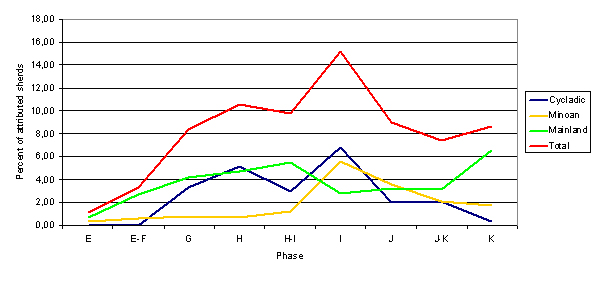
Fig. 2: Sherd count of the Vertical Stratigraphic Sequence and quantification of Imports
The creation of a uniform classification system for the site, covering all periods under study was the precondition for any statistical analysis. All pottery from undisturbed contexts was counted, weighed and classified. Figure 2 shows the sherd count by M. Lindblom (n=25.837) for the Q6 area at the “Südhügel”, particularly important for the MBA and LBA sequence, as well as the overall distribution of imported pottery over time.Depending on the desired resolution of analysis, the fabrics can be analysed separately or combined into tentative cultural circuits often employed in research on pottery exchange. Individual ceramic classes and shapes can now be analysed in terms of first appearance, continuity and demise at Kolonna. Note that the amount of pottery represented in Figure 2 is just a fraction of the total amount of recorded pottery (approximately 100.000 sherds). Particularly pottery of ceramic phases D to F is not well represented at the “Südhügel” but abundant in the areas of the fortification wall and the “Innenstadt”.
For a brief discussion of the various ceramic phases, the first appearance of imports and Kolonnas relations to other sites see also the chronological chart Table 1.
Ceramic Phase D: defines the beginning of the EH III period at Kolonna. Synchronisms with the first phase of Lerna IV can be made.
| Ceramic Phase E: is defined by a site-wide destruction horizon of the Kolonna V settlement and covers the middle and advanced part of the Early Helladic III period. Ceramic phase E is contemporary with second and third phase of Lerna. Imports from the Mainland are known and Cycladic imports make their first appearance; at the same time local potters start the imitation of Cycladic vessel in local clay. | 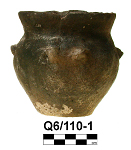 |
| Ceramic Phase F: covers the last and final part of the Early Helladic III period (Kolonna VI settlement phase) and is contemporary with third phase of Lerna IV |
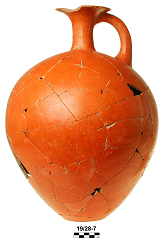  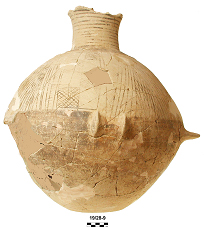 |
| Ceramic Phase G: defines the beginning of the MBA at Kolonna (late Kolonna VI and Kolonna VII settlement phase). Phase G find its best parallels at Lerna IV/V transitional phase or Asine Group A while this ceramic phase is lacking at Ayia Irini on Kea to present. |  |
| Ceramic Phase H: defines MH I (settlement phase Kolonna VIII). Aeginetan matt-painted pottery is attested for the first time and is found already in some |
   |
 |
quantities. Few Minoan MM I, perhaps even MM IA late Prepalatial, imports make their first appearance in phase H deposits, and in this phase Minoan type discoid loom weights are produced in local Aeginetan clay. |
| Ceramic Phase I: covers the MH II period and perhaps the very beginning of MH III (Kolonna IX settlement). Phase I pottery is found in the Aegina shaft grave and found in large quantities in the so called Large Building Complex, the MBA mansion of the site. Cretan imports of MM II and presumably MM IIIIA Protopalatial date, most of them likely from East/Central Crete, are found in some quantities, mainly fine pattern and solidly painted table ware, but also large storage containers. |
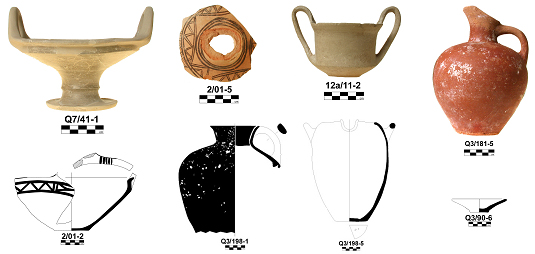 |
| Ceramic Phase J: covers the MH III period (Kolonna X settlement). Minoan imports, including the first stratified finding of a Minoan stone vessel indicate that the links to Crete still existed, even though the local Aeginetan production of the Minoan type pottery was interestingly abandoned in phase J. In this phase we also note an increase in pottery imports from Melos/Thera. |
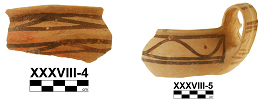 |
| Ceramic Phase K: covers the LH I ceramic phase. The phase K deposits originate from the “Südhügel” and the early LH Well deposit (Fig.4). A number of new imports (Mainland Polychrome, Matt Light on Burnished Dark and Mycenaean Decorated) originate from the Mainland and suggest an increased interest in this geographical area. At the same time we note first appearance of SE-Aegean Light on Dark (LoD) painted imports. At Kolonna and the Mainland, this is an exceptionally rare finding. |
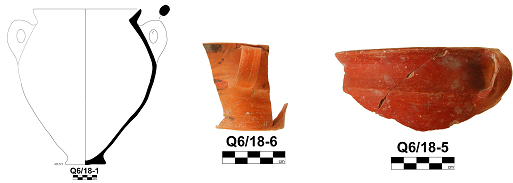 |
Ceramic Phase L: is yet not well defined. Stratigraphically it follows phase K and shows features of the LH II period. Aeginetan Bichrome painted pottery is present, as is Mycenaean pattern painted and unpainted LH II pottery. |
| Ceramic Phase M: is defined by the pottery associated with the construction, the period of use and the abandonment of the Mycenaean potters kiln. Pattern painted Mycenaean pottery is present but the quantities are not large and can be dated to LH IIIA. Most characteristic for phase M pottery is the locally produced Mycenaean style pottery, solidly painted Mycenaean pottery. Cypriote pottery of WS II style makes its first appearance in phase M and SE-Aegean imports still reach Kolonna. The locally produced matt-painted pottery reaches the final stages of its development and vanishes but is still exported to Athens, Kea and other sites. The so called Aeginetan kitchen ware is continued to be produced and exported until LH IIIC Early, after the end of the Mycenaean palatial period. | 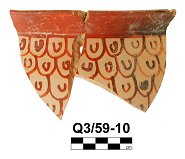 |
In collaboration with E. Kiriatizi (Fitch-Laboratories, BSA Athens) we were able to define and characterize the local pottery production and the various imports found at Kolonna. 42 different macroscopic groups of locally produced and imported pottery are defined to present, 19 of them confirmed by scientific analysis, the remaining groups will be scientifically analysed in a project scheduled for the future (Gauss – Kiriatzi in print). The degree of overlap between the macroscopic inspection and chemical, NA- and petrographic analysis is very high, almost 90%.
One of the most important results of recent research at Kolonna is the combination of the relative stratigraphic sequence with absolute dates. Approximately 50 samples were chosen for analysis, originating from animal bones and seeds. 46 samples were used for sequencing, including two samples analysed already in the 1980ies by the Hanover laboratories.
Most samples originate from the vertical stratigraphic sequence at the “Südhügel” (Fig. 1, C), but we were also able to incorporate samples from the two other areas of research, the “Innenstadt” and the Fortification wall (Fig. 1, A. B). The 14C data were combined with the information about the relative chronology of the samples derived from the stratigraphy by applying Bayesian statistics thus creating a sound framework of absolute dates for the boundaries of each ceramic phase, covering more than 600 years of cultural development. (Fig.3).
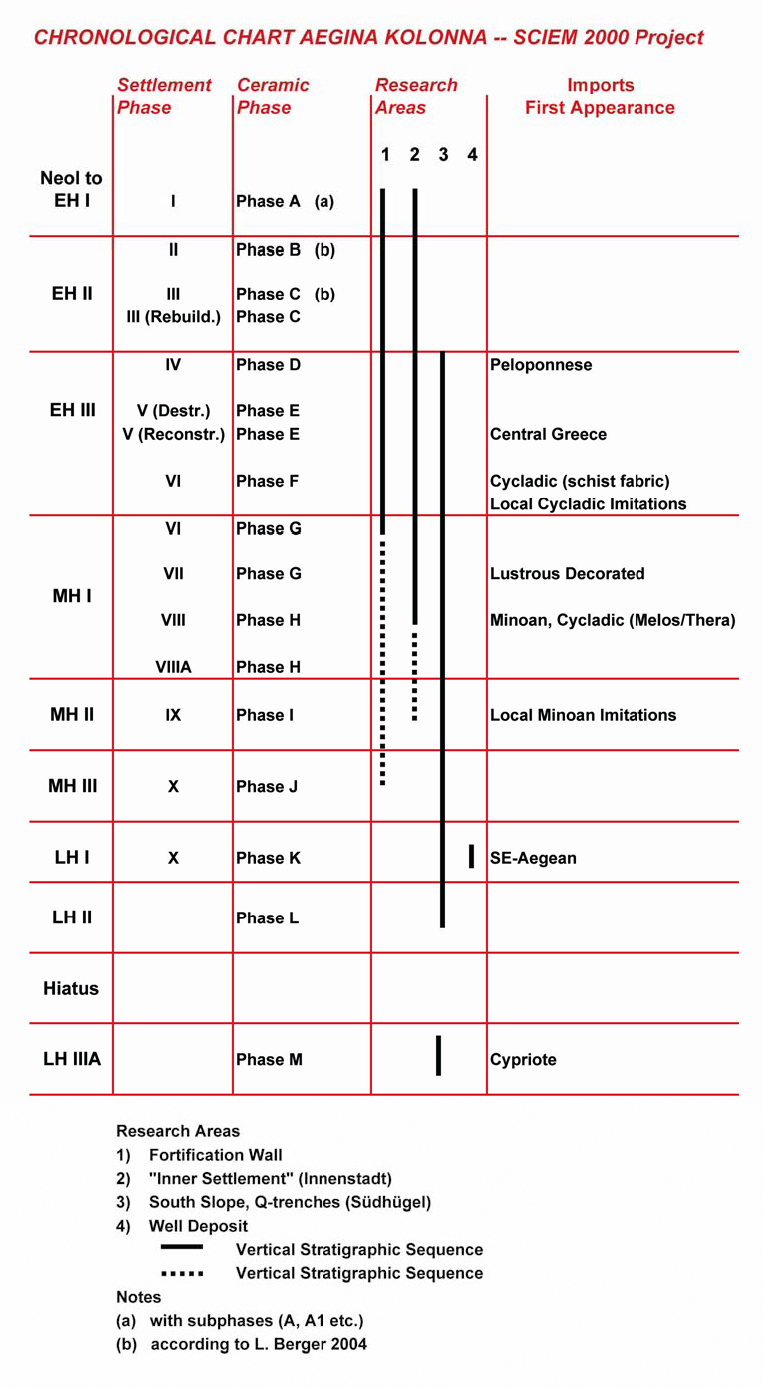
Fig. 3: Chronological Chart of the Bronze Age Stratigraphic Sequence at Kolonna
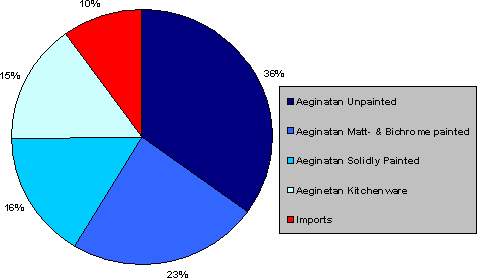
Fig.4: Well Deposit (Pottery Phase K) – Simplyfied overview of Classes of Pottery
n=700 kg
1W. Gauss, R. Smetana with contributions by M. Lindblom, K. Pruckner (ceramic sequence, stratigraphy, Statistics), E.°Kiriatzi (petrography, pottery production), P.°Steier, F°Weninger and E.°M.°Wild (14C data and sequencing).